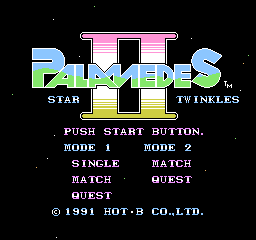Retro Replay Review
Gameplay
Palamedes II: Star Twinkles builds on the classic dice‐matching formula by placing your character directly atop an ever‐growing pile of dice. Rather than simply lining up dice on a static field, you must race against gravity itself—failing to clear the pile in time means being crushed under the weight of your own mistakes. This inversion of the original Palamedes gameplay gives every move a sense of urgency and stakes, and it evokes the same frantic tension of Tetris or Klax when the blocks—or in this case dice—begin to overwhelm you.
(HEY YOU!! We hope you enjoy! We try not to run ads. So basically, this is a very expensive hobby running this site. Please consider joining us for updates, forums, and more. Network w/ us to make some cash or friends while retro gaming, and you can win some free retro games for posting. Okay, carry on 👍)
The game offers two distinct modes that cater to different playstyles. Mode 1 has you rearrange dice within the stack to form either uniform lines (4‐4‐4‐4‐4) or ascending/descending sequences (1‐2‐3‐4‐5). You can tackle this solo in “single” mode, challenge a friend in “match” mode, or embark on a strategic “quest” against AI opponents of varying difficulty. Each variation tweaks pacing and introduces new dice patterns, keeping the core mechanic feeling fresh across extended play sessions.
Mode 2 ups the ante by locking in a densely packed pile of dice that cannot be shuffled internally. Instead, you must scan only the top layer for matches against the current target die. An opponent is doing the same, and the first one to clear their stack—or survive the countdown when neither can match—wins. This head‐to‐head scramble emphasizes quick thinking, rapid scanning, and split‐second decision‐making. It’s a clever twist that turns the puzzle into an all‐out reaction test when the timer starts ticking.
Graphics
Visually, Star Twinkles embraces a bright, cosmic theme that feels fitting for its interstellar subtitle. The dice themselves are rendered in bold primary colors with subtle shading that gives them a tangible, 3D look. Against the backdrop of twinkling stars and swirling nebulae, each successful elimination triggers a satisfying burst of sparkles, further reinforcing the game’s “star twinkle” motif.
User interface elements are clean and intuitive. Timers, current dice targets, and score counters are easy to read without cluttering the playfield. When you play in split‐screen multiplayer, the field is divided neatly, and the transparency of the opposing stack never obstructs your view. This ensures that even during the most heated races, you always know exactly where to focus.
Animations are smooth, from the tumbling dice when you rearrange them to the swift collapse of matched sequences. Special effects—such as a brief glow around eliminated lines or a quick screen shake when your character nearly gets crushed—add dramatic flair without feeling gratuitous. The overall presentation is polished and demonstrates clear care for both aesthetic consistency and functional readability.
Story
While Palamedes II: Star Twinkles isn’t a narrative‐heavy experience, it does offer a lighthearted framing to contextualize your dice‐matching adventures. You play as an intrepid cosmic explorer, leaping from nebula to nebula in search of the legendary “Star Twinkle Dice,” ancient artifacts said to hold unimaginable power. Each stage is framed as a different star system, complete with its own quirks—icy comets, magnetic anomalies, and drifting asteroid fields.
Between matches in quest mode, brief vignettes show your character interacting with other spacefarers who challenge you to dice duels. These encounters are illustrated with charming pixel art portraits and short dialogue bursts, adding personality without dragging down the gameplay flow. The dialogue often includes tongue‐in‐cheek references to dice lore and cosmic phenomena, giving the otherwise minimalist narrative a playful tone.
As you progress, the stakes gradually escalate—your journey culminates in a final duel against the enigmatic guardian of the Star Twinkle Dice. Though the story remains light at its core, this structure provides a satisfying sense of progression and achievement. It’s an excellent example of how a casual puzzle game can weave in just enough context to keep players motivated beyond chasing high scores.
Overall Experience
Palamedes II: Star Twinkles delivers a compelling twist on its predecessor’s puzzle formula, balancing frantic urgency with strategic depth. Mode 1 is a satisfying solo challenge or casual couch-co-op experience, while Mode 2 offers high‐octane head‐to‐head clashes that test both puzzle‐solving skills and reaction time. The dual‐mode approach ensures that both thoughtful planners and quick‐draw competitors will find something to enjoy.
The presentation is polished, with crisp visuals, readable UI, and just the right amount of flair in its animations and effects. Though the story is light, it punctuates the core gameplay with enough charm to keep players engaged on the journey to the final boss. The quest mode’s brief cutscenes and character encounters add personality without overstaying their welcome.
Replay value is high thanks to multiple difficulty levels, the variety of match types, and local multiplayer options. Whether you’re aiming for a personal best in single-player, outwitting the AI in quest mode, or besting a friend in frantic duels, Palamedes II keeps the dice-rolling action fresh and addictively fun. For puzzle veterans and newcomers alike, this sequel shines like the cosmic twinkles it’s named after.
 Retro Replay Retro Replay gaming reviews, news, emulation, geek stuff and more!
Retro Replay Retro Replay gaming reviews, news, emulation, geek stuff and more!









Reviews
There are no reviews yet.